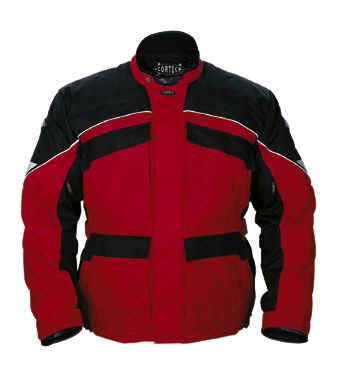Review of Tourmaster Cortech
Advanced 3/4 Jacket
by Marc Mauss
My first reaction when I saw the
new Cortech jacket was that it doesn't seem much different from the one I'd been
wearing for the last six years. The old one, btw, is still completely
serviceable, although it's losing its waterproofness after roughly 100,000 miles
of use. Then I looked more closely. My old jacket is at least two
generations behind the new one. I'll start by describing the visible
differences, and then go on to "wearability".
| The most obvious differences
are the additional reflective material on the new version (molded triangles
on the back and each sleeve, a panel at the top rear of each sleeve, and 360-degree piping) and the different shape: The old
one is a true 3/4-length, all the way around, while the new one is 3/4 in
the rear, but shorter in the front. This is a good thing. It
helps to keep the front of the jacket from collecting water when riding in
the rain. The jacket itself is waterproof, but the zipper can leak
if water pools in the folds.
What I think is the most significant
innovation is the venting system. Both the old and the new have
vents on the inner aspect of the upper arms, on the upper chest and on the
back, but the new one incorporates an ingenious opening system that
actually turns the front vents into scoops that catch a tremendous amount
of air and channel it through the jacket. This is especially
significant to me, as I ride a fully-faired bike and there's not much air
movement for me to catch.
The new version has even more storage
space than the old. In addition to the lower front pockets and
hand-warmer pockets behind them and the built-in fanny pack, all of which
are the same as on the old jacket, the breast pockets are now expandable
and have additional pockets behind them. There's also a small
cell-phone pocket on the inside.
Each of the outer pockets has a rubberized
tab that makes easy to pull the velcro open. |
 |
Where the old jacket had corduroy
at the cuffs and neck, the new has SOFT, washable sheepskin leather, and the
cuffs have stretch panels which make it easy to adjust. They've also added
adjustable forearm straps to keep the armor in place. Another convenience
is the new closure for the collar. The old one had a velcro tab that
secured under the collar when not in use, but my helmet strap often caught on it
when I turned my head. The new jacket has eliminated the extra tab, and
just widened the overlapping left flap that covers the zipper, which is sealed
with both velcro and a snap. Oh yes - they added another soft leather
patch both inside and out, right below your chin. It took me a while to
figure out that the snap hanging on a tab from the left breast pocket was for
keeping the collar from flapping when open.
The new jacket is more comfortable
than the old. The armor seems less bulky, yet if feels as if it will
afford the same protection (see note below). It
is, without question, every bit as waterproof as the old one was. I've
ridden through torrential downpours for hours without a leak. It's warm
enough that I suspect I'd be comfortable at any (rideable) temperature using
just the jacket, liner and electrics, without the need for additional
layers. Without the liner, its "Pipeline Ventilation System"
keeps it comfortable in all but the hottest weather.
The jacket is constructed with a combination of 500 denier
DuPont Cordura, 500 denier nylon and 1680 denier Ballistic Nylon, all with a
polyurethane coating for durability and water resistance. Then there's the
waterproof, breathable barrier, which, while remaining completely waterproof, provides breathability
for comfort.
The only thing I miss from the old
jacket is the tiny zipper pocket that was on the outside of the left lower
pocket, which I use for my key. I haven't yet found a spot that's as
convenient for that.
Note
on protection:
In November
of 1999, before I became an MSF Instructor, I crashed my bike. I slid
forty feet with the bike on top of me. No riding gear could have prevented
the seven broken ribs (from the weight of the bike falling on me), but my
Cortech pants and jacket completely prevented road rash, and I'm sure prevented
any additional injuries I might have sustained from hitting the pavement.
My pants had a small rip in the thigh pocket, right where I was carrying my
wallet, but my jacket came through completely unscathed until the paramedics
removed it with a pair of scissors.
